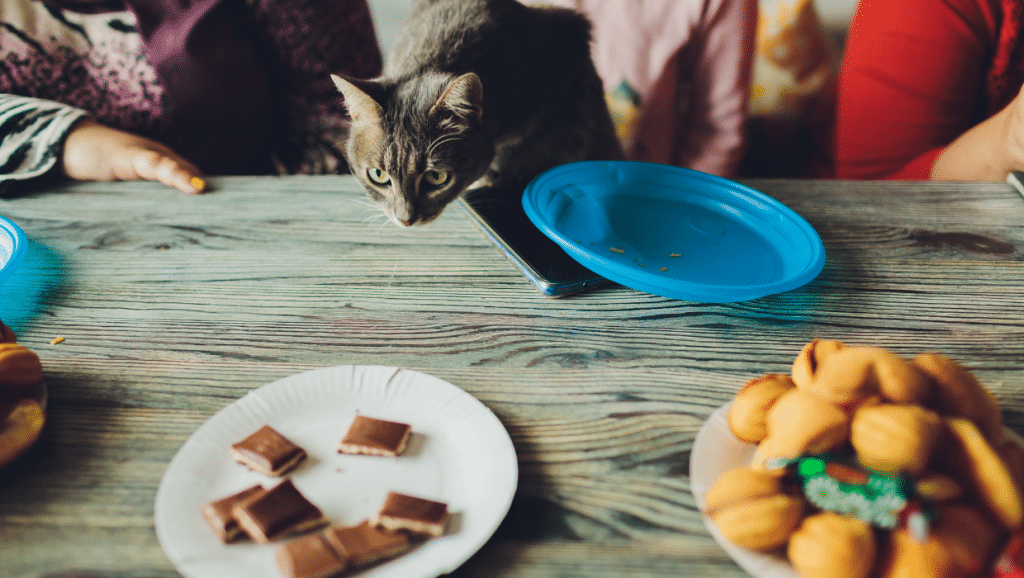Chocolate is as harmful to cats as it is for dogs and you should avoid leaving chocolate unattended around your house if you have a pet, as two substances found in chocolate are proven toxic to most animals even if they are just naturally occurring in cocoa and are not harmful to humans.

In this article, you will find just how bad it can get if your cat eats even what you consider ‘a small amount of chocolate’.
Can cats eat chocolate?
No. Cats should never eat any type of chocolate whether black, white, dark, or unsweetened, although the risk of eating baking and dark chocolate is higher than eating milk chocolate or white chocolate. Why?

All chocolate types contain the primary methylxanthines theobromine and caffeine, toxic substances that can lead to life-threatening cardiac arrhythmias (irregular heartbeats), central nervous system dysfunctions, and even death in cats, but theobromine is found in higher amounts in darker and unsweetened chocolate.
This means your cat is not interested in eating chocolate and is unlikely to eat a big amount of a chocolate product, but it doesn’t mean she won’t if highly curious, bored, and given the chance. Please be mindful of where you leave your cookies.
How much chocolate is bad for cats?

A few licks of chocolate ice cream or chocolate pudding won’t seriously hurt your cat, but what we consider a small amount of chocolate for us, even just 1 square, can be bad for cats. Depending on your cat’s body weight and how much chocolate she consumed and how ‘dark’ the chocolate was, even 20mg of theobromine per pound of your cat’s weight can cause serious health problems.
If your cat weighs about 8lb (3.6kg) and has ingested 0.5oz (14g) of dark or semi-sweet chocolate or 0.2oz (5.5g) of baking chocolate it can already be toxic.
An average domestic cat weighs about 10 pounds (4.5 kg) so you should be very worried if your cat eats a thin slice of chocolate cake or 1 square of unsweetened baking chocolate.
We advise you to call your vet in case of any chocolate ingestion, no matter how small, because even a few licks can cause some minor symptoms and an upset stomach.
What happens if a cat eats chocolate?
The first symptoms of chocolate toxicity in cats occur within 6 to 12 hours after the ingestion of chocolate. Your cat will show the first signs of chocolate toxicosis such as increased thirst, vomiting, diarrhea, bloating, and restlessness.

These signs will then progress into hyperactivity, rapid breathing, excessive urination (Polyuria), impaired coordination, and the loss of full control of bodily movements (Ataxia), rigidity, muscle spasms, and seizures.
More severe signs may occur after that, depending on the amount consumed: rapid and abnormal heartbeats (Tachycardia and Tachypnea), premature ventricular contractions (extra heartbeats starting in a lower pumping chamber of the heart ) or bradycardia (slower-than-expected heartbeats), cyanosis or blue skin (a bluish discoloration of the skin resulting from poor circulation or inadequate oxygenation of the blood), high blood pressure or low blood pressure (hypertension or hypotension), high body temperature (hyperthermia) and coma.
Late in the stages of chocolate intoxication a low level of potassium in the blood may occur (Hypokalemia) that will lead to heart dysfunctions and arrhythmias that along with hyperthermia may result in respiratory failure and death.
My cat ate chocolate, what should I do?
If you saw your feline friend consuming chocolate or you suspect your cat has eaten chocolate, call your personal veterinarian immediately, the local vet, or the closest emergency veterinary clinic for decontamination within 1 hour of ingestion before any clinical signs have developed. Preferably, you can call the ASPCA 24h Animal Poison Control Center at the phone number (888) 426-4435 any time. A consultation fee of about 65$ might apply, but rest assured your vet will also charge a fee in case of an emergency out of operating hours.
Treatment for cats that have eaten chocolate
In case your cat already shows symptoms of chocolate poisoning stabilizing procedures will need to be performed by the vet depending on the severity of the diagnostic as severe cases can last up to 72 hours from ingestion.
Your cat might need blood and urine tests to determine the best treatment for the case.

Stabilizing procedures can be fluid therapy to keep your cat hydrated, induced vomiting, frequent administration of activated charcoal, gastric lavage (the process of cleaning out the contents of the stomach) when the cat has been sedated due to seizures, thermoregulation (maintaining the body’s normal temperature), correcting acid-base and electrolyte abnormalities, monitoring your cats cardiac status, and even placing a urinary catheter, a flexible tube that collects urine from the bladder and leads to a drainage bag.
Please seek veterinary advice in case your cat has consumed any poisonous foods!
Keep poisonous foods out of your cat’s paw reach!

To prevent your cat from eating any chocolate or any other harmful and toxic human foods for felines, store the harmful foods in sealed storage containers, and out of the kittie’s reach in pet-proof cabinets if necessary. Additionally, teach your cat to don’t jump on the counter or tables while you are cooking or eating, and do not feed your cat your table scraps and leftovers keeping her on a diet of healthy cat food and the occasional cat treats. Make sure there is no food left in the kitchen sink that your cat can lick and keep garbage bins covered.
Cats should not eat chocolate
Cats should not have chocolate, even in small amounts, as depending on your cat’s weight it can lead to serious health issues and life-threatening situations. A few licks of chocolate from time to time won’t harm your cat, but ingesting even one square of the dark chocolate types can. Chocolate contains 2 substances most toxic to cats, theobromine, and caffeine which are poisonous and should be avoided at all times, as they can cause vomiting, diarrhea, muscle tremors, heart arrhythmias, seizures, and depending on the chocolate toxicity even coma, respiratory failure, and death. Please keep all chocolate away from your feline companions to avoid any dangerous situations and be a responsible pet owner.
We would love to hear your thoughts, pawlease leave us a message in the comments below and don’t furget to stay pawsome!






